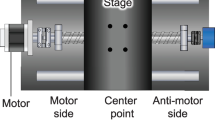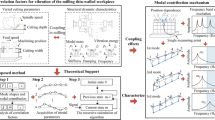Abstract
In machining processes, cutting forces measurement is essential to allow cutting process and tool conditions monitoring. Moreover, in order to have information about the quality of the milled part, the amplitude of the tool tip vibration would be very useful. Since both the measurements are extremely complicated especially in an industrial scenario, in this study, an in-process model-based estimator of cutting forces and tool tip vibration was designed and properly tested. The developed estimator relies on both a machine dynamic model and on indirect measurements coming from multiple sensors placed in the machine. The machine dynamic model was obtained through an experimental modal analysis session. The estimator was developed according to the Kalman filter approach. The fusion of multiple sensors data allowed the compensation of machine tool dynamics over an extended frequency range. The accuracy of the observer estimations was checked performing two different experimental sessions in which both the force applied to the tool and the tool tip vibration amplitude were measured. In the first session, the tool was excited with different sensorized hammers in order to appreciate the broad bandwidth of the performed estimations. In the second one, real cutting tests (steel milling) were done and the cutting forces were measured through a dynamometer; tool tip vibrations were measured as well. The experimental results showed that the indirect estimation of cutting forces and tool tip vibrations exhibit a good agreement with respect to the corresponding measured quantities in low and high frequency ranges. The contribution of this research is twofold. Firstly, the conceived observer allows estimating the tool tip vibrations that is a useful information strictly connected to the surfaces quality of the processed workpiece. Secondly, thanks to a multi-sensors approach, the frequency bandwidth is extended especially in the low frequency range.
Similar content being viewed by others
References
Andrews GC, Tlusty J (1983) A critical review of sensors for unmanned machining. CIRP Ann Manuf Technol 32(2):563–572
Byrne G, Dornfeld D, Inasaki I, Ketteler G, Konig W, Teti R (1995) Tool condition monitoring (TCM)—the status of research and industrial application. CIRP Ann Manuf Technol 44(2):541–567
Tonshoff HK, Wulfsberg JP, Kals HJJ, Konig W, van Luttervelt CA (1998) Development and trends in monitoring and control of machining process. CIRP Ann Manuf Technol 37(2):611–622
Lee P, Altintas Y (1996) Prediction of ball end milling forces from orthogonal cutting data. Int J Mach Tools Manuf 36(9):1059–1072
Teti R, Jawahir IS, Jemielniak K, Segreto T, Chen S, Kossakowska J (2006) Chip form monitoring through advanced processing of cutting force sensor signals. CIRP Ann Manuf Technol 55(1):75–80
Teti R, Jemielniak K, O’Donnell G, Dornfeld D (2010) Advanced monitoring of machining operations. CIRP Ann Manuf Technol 59(2):717–739
Smith DA, Smith S, Tlusty J (1998) High performance milling torque sensor. J Manuf Sci Eng 120(3):504–551
Aoyama H, Inasaki I, Suda I, Ohzeki H (1998) Prediction of tool wear and tool failure in milling by utilizing magnetorestrictive torque sensor. Technical papers of the North American Manufacturing Research Institution of SME, pp. 125–130
Park SS, Altintas Y (2004) Dynamic compensation of spindle integrated force sensors with Kalman filter. Int J Dyn Syst Meas Control 126(3):443–452
Albrecht A, Park SS, Altintas Y, Pritschow G (2005) High frequency bandwidth cutting force measurement in milling using capacitance displacement sensors. Int J Mach Tools Manuf 45(9):993–1008
Kim JH, Chang HK, Han DC, Jang DY (2005) Cutting force estimation by measuring spindle displacement in milling process. CIRP Ann Manuf Technol 54(1):67–70
Sarhan AD, Matsubara A, Sugihara M, Saraie H, Ibaraki S, Kakino Y (2006) Monitoring method of cutting force by using additional spindle sensors. JSME Int J Ser C 49(2):307--315
Tonshoff HK, Inasaki I (2001) Sensors in manufacturing. Wiley-VCH, Weinheim. ISBN 3-527r-r29558-5
Chae J, Park SS (2007) High frequency bandwidth measurements of micro cutting forces. Int J Mach Tools Manuf 47(9):1433–1441
Salehi M, Albertelli P, Goletti M, Ripamonti F, Tomasini G (2014) Indirect model based estimation of cutting force and tool tip vibrational behaviour in milling machines by sensor fusion. 9th CIRP Conference on Intelligent Computation in Manufacturing ICME, Naples, Italy
Möhring HC, Litwinski KM, Gümmer O (2010) Process monitoring with sensory machine tool components. CIRP Ann Manuf Technol 59(1):383–386
Denkena B, Hackelöer FL (2010) Multi-sensor disturbance force measurement for compliant mechanical structures. 9th Annual IEEE Conference on Sensors. Seoul, p 2518–2524
Jiang H, Long X, Meng G (2008) Study of the correlation between surface generation and cutting vibrations in peripheral milling. J Mater Process Technol 208(1–3):229–238
Montgomery D, Altintas Y (1991) Mechanism of cutting force and surface generation in dynamic milling. J Manuf Sci Eng 113(2):160–168
Paris H, Peigne G, Mayer R (2004) Surface shape prediction in high speed milling. Int J Mach Tools Manuf 44(15):1567–1576
Peigne G, Paris H, Brissaud D, Gouskov A (2004) Impact of the cutting dynamics of small radial immersion milling operations on machined surface roughness. Int J Mach Tools Manuf 44(11):1133–1142
Cheung CF, Lee WB (2000) Modelling and simulation of surface topography in ultra-precision diamond turning. J Eng Manuf 214(6):463–480
Albertelli P, Cau N, Bianchi G, Monno M (2012) The effect of dynamic interaction between machine tool subsystems on cutting process stability. Int J Adv Manuf Technol 58(9–12):923–932
Albertelli P, Elmas S, Jackson MR, Bianchi G, Parkin RM, Monno M (2012) Active spindle system for a rotary planing machine. Int J Adv Manuf Technol 63:1021–1034
Albertelli P, Goletti M, Monno M (2013) A new receptance coupling substructure analysis methodology to improve chatter free cutting conditions prediction. Int J Mach Tool Manuf 72:16–24
Movahhedy MR, Gerami JM (2006) Prediction of spindle dynamics in milling by sub-structure coupling. Int J Mach Tool Manuf 46:243–251
Author information
Authors and Affiliations
Corresponding author
Rights and permissions
About this article
Cite this article
Albertelli, P., Goletti, M., Torta, M. et al. Model-based broadband estimation of cutting forces and tool vibration in milling through in-process indirect multiple-sensors measurements. Int J Adv Manuf Technol 82, 779–796 (2016). https://doi.org/10.1007/s00170-015-7402-x
Received:
Accepted:
Published:
Issue Date:
DOI: https://doi.org/10.1007/s00170-015-7402-x




